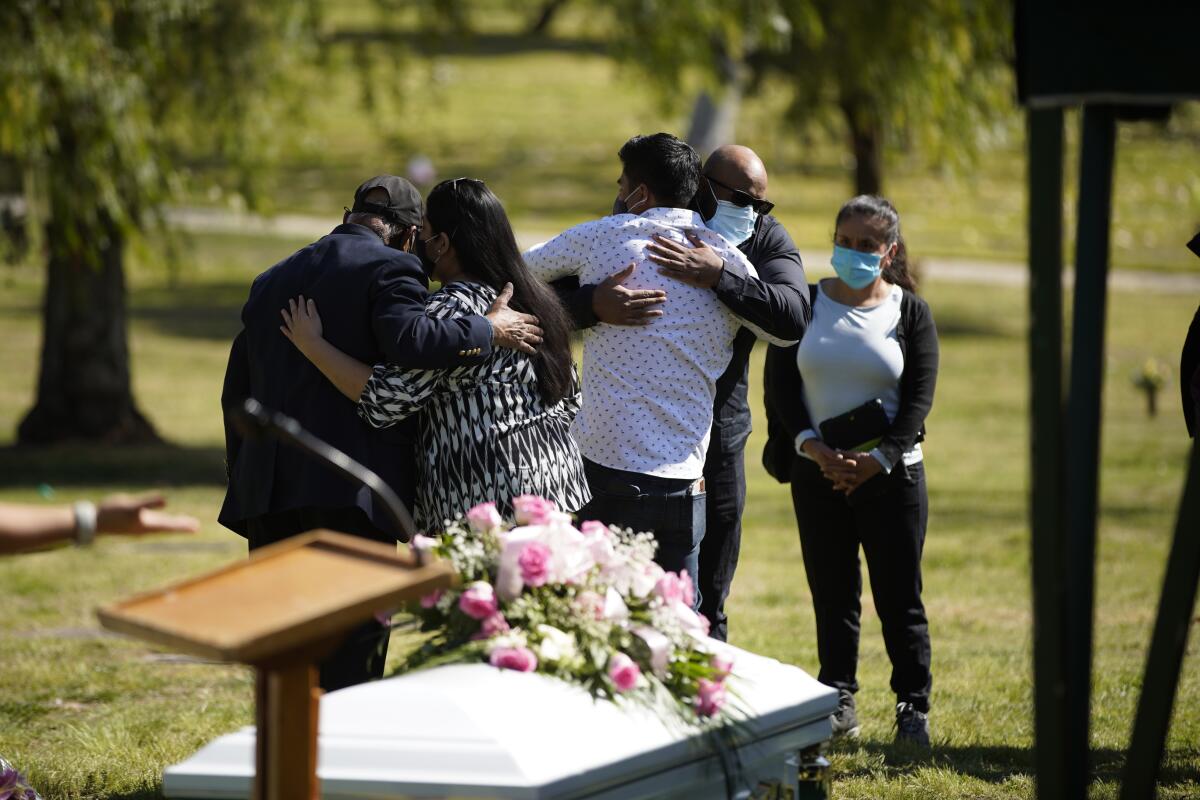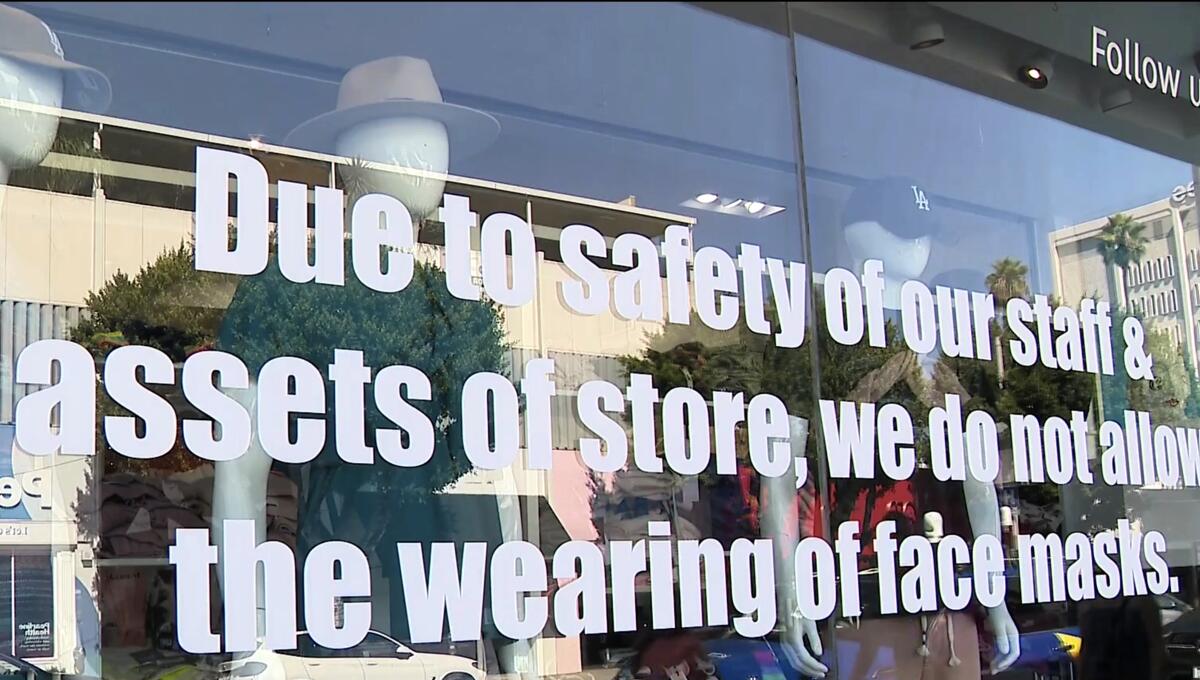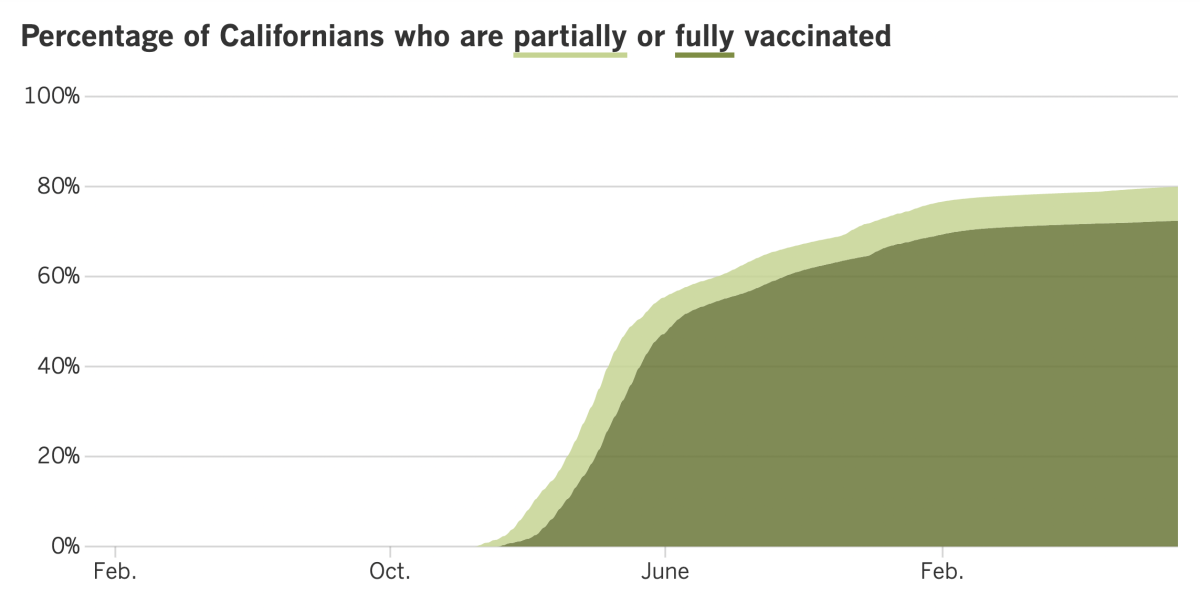Coronavirus Today: The years of life lost to COVID-19
- Share via
Good evening. I’m Karen Kaplan, and it’s Tuesday, Aug. 30. Here’s the latest on what’s happening with the coronavirus in California and beyond.
Sometimes the toll of COVID-19 is hard to fathom. More than 1 million Americans have died of the disease — 1,039,055 as of Tuesday, according to the Centers for Disease Control and Prevention — but numbers that large are necessarily abstract.
How about this: The life expectancy for Americans born in 2021 is 2.7 years lower than for Americans born in 2019, just before the coronavirus arrived in the U.S.
Or what about this: Babies born last year can expect to live 76.1 years, on average. That’s the lowest life expectancy this country has seen in 25 years.
There’s also this: Prior to the pandemic, the last time life expectancy in the U.S. dropped so much over a two-year period was all the way back in 1921-23.
Facts like these bring into sharp focus the truly historic nature of what the country has been going through. And although the death toll of the second Omicron wave is far below those seen in previous surges, roughly 400 Americans are still dying of the disease every day.
The life expectancy figures are from a report released Tuesday night by the CDC’s National Center for Health Statistics. They incorporate provisional death counts for 2021 and thus may change slightly when all the final numbers are in.

The report is full of disheartening information, such as the fact that 42% of the decline in life expectancy among white Americans occurred in 2021, even though COVID-19 vaccines were widely available by the end of spring. (For other racial and ethnic groups, the overwhelming majority of life expectancy decline was due to deaths in the first year of the pandemic.)
It also reminds us that other demographic disparities have not gone away.
For instance, males lost more years (3.1) than females (2.3). As a result, a baby girl born in 2021 can expect to live to the age of 79.1, while the average baby boy will make it to 73.2 — a difference of 5.9 years.
The group the CDC calls “American Indians or Alaska Natives” experienced the biggest drop in life expectancy, losing 6.6 years after the pandemic came along. Their average life expectancy in 2021 stood at 65.2 years, the same as it was for Americans as a whole back in 1944.
Latinx Americans lost 4.2 years, resulting in an average life expectancy of 77.7 years; Black Americans lost 4 years, resulting in an average of 70.8; white Americans lost 2.4 years, bringing their average to 76.4; and Asian Americans lost 2.1 years, for an average of 83.5.
Overall, COVID-19 was responsible for half of the decline in life expectancy that occurred between 2020 and 2021. Coming in a distant second was unintentional injuries, a category that includes drug overdoses.
COVID-19 was the primary reason life expectancy fell for white Americans, accounting for 54.1% of the decline. It also was the top cause for Black Americans, explaining 35% of the year-to-year decline. For both Latinx and Asian Americans, COVID-19 was the secondary culprit, trailing unintentional injuries for the former group and cancer for the latter.
Even more years of life would have been lost if it weren’t for the significant declines in the numbers of Americans dying of influenza, pneumonia and chronic lower respiratory diseases. Some of those deaths were surely averted by the precautions Americans took to avoid COVID-19.
A separate report from the National Center for Health Statistics that examined life expectancy by state found that every single one saw life expectancy decline between 2019 and 2020. (So did the District of Columbia.) Residents of some states lost as little as 0.2 years, while others lost as much as 3 full years.
Californians lost 1.9 years, on average, dropping life expectancy at birth in the Golden State from 80.9 to 79. That’s still two years more than the national average of 77, but the decline in longevity dropped California from second to fourth place among all states.
The U.S. Census Bureau says the first year of the pandemic prompted the largest year-to-year increase in deaths the country has seen in a century.
By the numbers
California cases and deaths as of 4:22 p.m. on Tuesday:

Track California’s coronavirus spread and vaccination efforts — including the latest numbers and how they break down — with our graphics.
Public safety measure or publicity stunt?
L.A. Times reporter Salvador Hernandez was speaking with Kitson boutique owner Fraser Ross last week when Ross put the conversation on pause.
“There’s a customer coming in with a mask,” he told Hernandez, “and I need to tell them they can’t come in with one.”
It sounded like just another publicity stunt from a man with a long history of using celebrities, social media and creative window displays to steal the spotlight. But Ross insisted his mask ban was implemented for one reason only — to prevent thefts and robberies at his flagship L.A. shop, two blocks from Beverly Hills.
“Due to safety of our staff & assets of store, we do not allow the wearing of face masks,” explained a message stenciled onto the boutique’s front windows.

As Ross explained it, the mask ban was prompted by a crime wave in the upscale Westside neighborhood. Businesses in the area have been targeted, he said, and one of his employees was threatened by an assailant armed with a pair of scissors.
“We’re living in Gotham City,” he told Hernandez darkly. Crime “is at an all-time level.”
Maybe, maybe not. Crime statistics from the Los Angeles Police Department’s Wilshire Division show that robberies in the area through mid-August were 24% higher in 2022 than in the same period last year. Burglaries rose 9% compared to 2021 but are down 31% compared to 2020. And total violent crime has been essentially flat over the last three years.
Ross puts more stock in his personal experience, including an incident a few weeks back involving two women whom he thinks have a history of shoplifting from his store. He couldn’t be sure of their identities, he said, because they were wearing face masks. It was the final straw.
“I was sick of people coming into this store, and we can’t get them from a lineup,” he said. “They wear bucket hats, hoodies, and you can only see their eyes. You can’t say that’s the right person.”
That said, Ross’ opposition to masks — not to mention pandemic lockdowns and COVID-19 vaccines — goes well beyond any recent crime spree.
In a 2020 holiday-themed window display, for instance, he skewered Dr. Anthony Fauci and House Speaker Nancy Pelosi as “hypocrites” for appearing in public sans masks. And when Fauci recently announced his decision to retire from government service in December, Ross wrote on Instagram, “Don’t let the door hit you on the way out. Please take all your masks with you that you never wear.”
Whatever its true motivation, the mask policy at Kitson won’t have much impact on the community’s health, because most shoppers haven’t been wearing them anyway.
“There were a few people coming in with masks,” Ross said, “but the rest are criminals.”
California’s vaccination progress


See the latest on California’s vaccination progress with our tracker.
Your support helps us deliver the news that matters most.
In other news ...
It’s normal to experience back-to-school jitters. These days, the ones feeling nervous are public health officials and other medical experts.
Their concern is for California’s younger students who are returning to classrooms without the safety nets of an indoor mask mandate or routine coronavirus testing. The willingness to move forward without them reflects confidence in the ability of schools to reduce risk in other ways, such as improved ventilation systems that do a better job of pulling coronavirus particles out of the air.
But the low vaccination rates among younger children may leave them vulnerable, despite other signs of progress, some experts fear.
Although 72% of all Californians have completed their primary vaccination series, only 37% of the state’s children between the ages of 5 and 11 are fully vaccinated, according to data from the state Department of Public Health. Among adolescents ages 12 to 17, the vaccination rate is 67%.
In Los Angeles County, 73% of residents are fully vaccinated, according to the local health department. That includes 35% of 5- to 11-year-olds and 79% of 12- to 17-year-olds.
The surge fueled by the BA.5 subvariant of Omicron is waning, and younger children might be OK for now, regardless of their vaccination status. But if a third consecutive winter surge materializes, the lack of vaccine protection could become a problem.
“Get your child vaccinated,” urged UC San Francisco pediatrician and epidemiologist Dr. George Rutherford.
Speaking of COVID-19 vaccines, updated versions that target BA.5 along with the original coronavirus strain are getting closer to prime time. The CDC’s Advisory Committee on Immunization Practices will be discussing the so-called bivalent vaccines at a meeting Thursday. The committee is expected to debate whether the reformulated shots should be made available to booster-eligible people across the board or only to certain groups, perhaps based on age or health status.
Pfizer and Moderna have asked the Food and Drug Administration to authorize their bivalent vaccines. Normally, the FDA would act on those requests before the CDC’s advisory committee meets, and many observers are expecting an FDA announcement on Wednesday. Assuming it’s a green light, CDC Director Dr. Rochelle Walensky can make a decision about recommending them after the advisory committee votes. (She doesn’t have to follow its advice, but she usually does.)
All of those steps would put the country on track to roll out the new boosters in early September, meeting a goal often stated by White House COVID-19 response coordinator Dr. Ashish Jha.
The new shots could be a substantial upgrade “in terms of their ability to prevent infection, to prevent transmission, certainly to prevent serious illness and death,” he said.
Dr. Peter Marks, the FDA’s vaccine chief, shared Jha’s optimism. “The hope here is that by better matching things, not only will we get that benefit or even more, but we’ll also have that last for a longer period of time,” he said.
But Dr. Paul Offit, a vaccine expert at Children’s Hospital of Philadelphia, reminds us that the new booster may not live up to expectations. A similar shot designed to target the BA.1 Omicron strain was “underwhelming,” he noted.
Moderna injected a dose of drama into the the vaccine world Friday by suing Pfizer and its partner BioNTech for patent infringement. Moderna accused its competitors of copying its mRNA technology, which delivers genetic code to a vaccine recipient’s cells so they will construct a protein that trains the immune system to recognize and fight a real virus.
Moderna said it has been working on its mRNA technology since 2010 and spent billions of dollars to perfect it. Some of that work was copied by Pfizer and BioNTech, according to the suits.
A spokeswoman for Pfizer said the vaccine co-developed with BioNTech is based on proprietary technology developed by the two companies, and BioNTech said their work was “original.” Both companies said they would fight the lawsuit.
Moderna said it isn’t trying to halt sales of its competitors’ vaccine. Instead, it seeks licensing fees for sales in high-income countries. Moderna is not enforcing its patents for vaccines used in low- and middle-income countries.
There’s been more disappointing news for Pfizer: A large study published last week in the New England Journal of Medicine found that Paxlovid offered little to no benefit for adults ages 40 to 65.
That lackluster performance may have more to do with the state of the pandemic than with the antiviral pill itself, experts said. By and large, the recent versions of Omicron have tread more lightly on younger, healthier people — especially considering that most of them have acquired some level of immune protection from vaccines, past infection or a combination of the two. If the coronavirus isn’t as dangerous to start with, it’s harder for a pill to make things better.
However, the study confirmed earlier findings that Paxlovid is helpful for older adults. Among those 65 and older, it reduced the risk of hospitalization by about 75% when started soon after an infection.
Finally, if you haven’t requested your free coronavirus tests yet, you’d better stop procrastinating. The federal program is being suspended Friday “because Congress hasn’t provided additional funding to replenish the nation’s stockpile,” according to COVID.gov.
The program provides up to 24 tests per household, with delivery by the U.S. Postal Service. When the first two rounds of tests were made available in January and March, households received four tests each. The current round, which began in May, offers eight tests.
If you missed any of those rounds, you can place an order now — and you’ll get eight tests per eligible round. (Your procrastination might have paid off!) You can sign up online at special.usps.com/testkits or by calling (800) 232-0233. The TTY number is (888) 720-7489.
Your questions answered
Today’s question comes from readers who want to know: How can I tell if my COVID-19 tests are expired?
This seems like it ought to be a question with a simple answer: Just check the date printed on the box.
The reason it’s not that simple is that the FDA has extended the official shelf life of some at-home test kits. The reason for those extensions is that manufacturers are conducting “stability” tests to confirm that they work beyond the four- to six-month periods for which they were initially authorized.
The FDA explains that the initial expiration dates were chosen based on the results of “accelerated” stability tests that simulated the passage of time by storing the COVID-19 test kits at higher temperatures. (NASA does the same thing when it tests food designed for multiyear space missions.)
But the most reliable way to know that a test kit will last for a year is to make one, wait a year (actually, 13 months, so you know you have a little wiggle room), then open the package and use it. If the components are in working order and the results are accurate, you know the shelf life can be extended.
The unavoidable downside of this process is that it takes time. So the FDA started with conservative shelf life estimates and is extending them as the data come in.
To get the updated expiration date for the test kits stashed in your medicine cabinet, go to the FDA’s List of Authorized At-Home OTC COVID-19 Diagnostic Tests and search the grid for your test. The column on the far right will give the latest information on how long your kit will be reliable. In many cases, that includes a link to a page that lists the current expiration dates according to the lot number printed on the package.
So if you find a kit that’s been buried under your sink, and the printed expiration date is long gone, don’t just throw it away. If you check the FDA website first, you might be pleasantly surprised.
We want to hear from you. Email us your coronavirus questions, and we’ll do our best to answer them. Wondering if your question’s already been answered? Check out our archive here.
The pandemic in pictures

That’s tennis star Novak Djokovic sitting with his son Stefan at a basketball game in Belgrade. They were there to cheer on the Serbian team in a qualifying game against Greece for the FIBA Basketball World Cup.
That game was played Thursday — four days before the start of the U.S. Open, the final Grand Slam tennis tournament of the year. Djokovic has won 21 Grand Slam titles, and one more would tie Rafael Nadal’s record of 22. (Roger Federer has 20.)
So why was Djokovic watching a basketball game in Serbia instead of playing tennis in Flushing Meadows, N.Y.? Because he isn’t vaccinated against COVID-19. International travelers can board a plane to the U.S. only if they’ve finished the primary series of an accepted COVID-19 vaccine. (There are a few exceptions, but none apply to Djokovic.)
The U.S. Tennis Assn., which runs the tournament, said it would follow the government’s rules about COVID-19 vaccines. That left Djokovic with two options: Roll up his sleeve or withdraw. He chose the latter.
“Sadly, I will not be able to travel to NY this time for US Open,” he announced on Twitter. “Good luck to my fellow players! I’ll keep in good shape and positive spirit and wait for an opportunity to compete again. See you soon tennis world!”
The next Grand Slam on the tennis calendar is the 2023 Australian Open in January. If he remains unvaccinated, he might not be playing there, either. You may recall that after Djokovic flew to Melbourne to defend his 2021 Australian Open title, his visa was canceled and he was deported.
Resources
Need a vaccine? Here’s where to go: City of Los Angeles | Los Angeles County | Kern County | Orange County | Riverside County | San Bernardino County | San Diego County | San Luis Obispo County | Santa Barbara County | Ventura County
Practice social distancing using these tips, and wear a mask or two.
Watch for symptoms such as fever, cough, shortness of breath, chills, shaking with chills, muscle pain, headache, sore throat and loss of taste or smell. Here’s what to look for and when.
Need to get a test? Testing in California is free, and you can find a site online or call (833) 422-4255.
Americans are hurting in various ways. We have advice for helping kids cope, as well as resources for people experiencing domestic abuse.
We’ve answered hundreds of readers’ questions. Explore them in our archive here.
For our most up-to-date coverage, visit our homepage and our Health section, get our breaking news alerts, and follow us on Twitter and Instagram.




